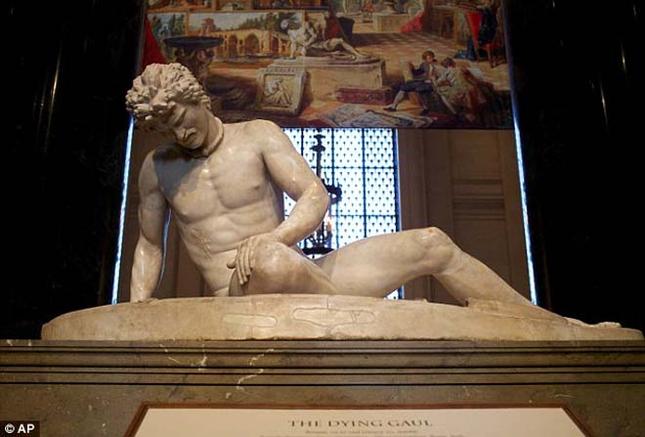Occasionally, a work of art comes along that cuts right through the static noise of the modern scene. It reflects the burden and balance of history and unveils for a moment the tragic beauty of human nature. Time falls by its side, as the past and present collide before it with startling immediacy, free from distortions, interferences and distractions. It is transcendent without need of religion, it is celestial while inextricably bound to the dirt of this earth. “The Dying Gaul” is one of these rare and consummate masterworks.
An ancient Roman marble sculpture created during the first or second century A.D., “The Dying Gaul” is a Gallic warrior, shown in his final moments of life, fallen from a mortal wound to his chest with his weapons and armor by his side. Long recognized as one of the renowned works from antiquity, it has not left Rome since 1797, when Napoleonic forces took the sculpture to Paris and had it displayed in the Louvre until 1816. Now on display in the rotunda of the National Gallery in coordination with the Embassy of Italy, this brief but historic exhibit is a gesture of cultural connectivity, in celebration of the ties that bind the United States and Italy, as well as the considerable influence that Italy’s history has had in shaping this country’s identity.
There is so much history with a work like this, from its discovery in the gardens of an Italian villa in the 1620s to the early misconceptions that it was a Roman gladiator or a Greek herald. It is, in fact, a Roman copy of a Greek bronze, originally created in the third century B.C. in Asia Minor to commemorate the victory of the king of Pergamon over the invading Gauls. They were evidently brought to Rome, where they would have reminded Romans of their own conquest of Gaul.
Not that this is really that important when standing before the dying soldier. Experiencing the force of this work makes the whole of Western art history feel at once totally dismissible and densely concentrated into a single, present moment.
The warrior hunches over with his head down, legs fallen out underneath him. The cut of the marble informs the figure, as the striated veins and mineral impurities of the stone are like kicked-up dust caking the soldier’s bare back. Slight cracks in the sculpture mimic battle scars.
The musculature is almost devastating. Visible are the seizures and contractions of a body broken, the forearms bulging, biceps in spasm, legs heavy, ribs constricting, chest sliced open and heaving, the warrior growing more faint with each breath. The body, held up by the wide back and shoulders, is full of vitality and life that it will never again experience. The Gaul is exhausted but determinedly strong, living in the prime of his life until the moment death takes him.
His head hangs wearily, as exquisitely carved as the rest of him. However, even hoisted above us on a pedestal the face is obscured by shadow. And though photographed in proper lighting on the surrounding panels for all to see, it feels inappropriate to hunch over and steal a look into the soldier’s eyes, as if to do so is a public exploitation of human suffering.
I think it is meant to be this way. In much the same way that we cannot stare coolly into the face of a crying friend, we see here the glimpse that the Gaul offers us—not the full brunt of his pain, but a sorrow that he obscures in search for solace and privacy amidst the chaos of his final moments. It is frankly a suggestion of something eternal that we can only ever realize in our hearts and minds. It is important to recognize that not everything can be shown, and it is often just as important to understand those things that can never be fully expressed to round out the sensation of being human.
To exhibit the Gaul in the rotunda of the National Gallery is a strangely Roman affectation, reminiscent of the political ethos of the ancient empire that originally put him on display. As an image of a vanquished enemy, the sculpture embodies courage in defeat, self-possession in the face of death and the recognition of nobility even in opposition. In the context of Washington, it fits in the gallery’s vaulted dome with its black marble columns like a brutalized political dissident on display, meant to impress and influence rather than inspire or enlighten. It distracts slightly from the ability to admire this as a work of art and shifts focus instead on its cultural and political poignancy. It would have been nice to view it in a more intimate gallery setting, unencumbered by the noise and distractions of gathering tour groups and the flow of visitors through the museum entrance. This, however, is probably how the Gaul felt on the battlefield.
Nevertheless, as the year comes to an end and the robes of winter wrap heavily around us, it is a beautiful experience to stand before a single work of art that lets us consider all that has passed by us, all that is yet to come, all that we are and all that we will never have the chance to be. Time and life are fickle and finite, but there is no discernable limit to the human spirit. ?
“The Dying Gaul” is on view at the National Gallery of Art through March 16. For more information, visit www.nga.gov.


